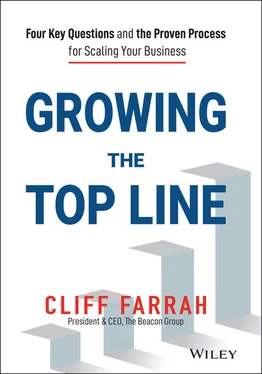We need our existing customers most in the world that I come from. In professional services your existing client base is probably 70% to 80% plus of your revenue stream, and yet if we don’t have that 20% of new client growth, ultimately, businesses will plateau or decline because of churn with the existing client base. So we need new clients.
Doug is spot on with this assessment in our world and truly for most businesses. All money comes from customers. New customers are the hardest thing to add, and they represent growth. Doug went on to describe other value new clients provide:
From a cultural and organizational behavior perspective, you need that new client base to create excitement and growth opportunities for your people! If your business is growing, you’re going to have opportunities for everyone. So from a behavioral and a financial standpoint, I think new client growth is important and I have spent my focus over the last 5 years for both of these books on how to win new client business. And I made it very clear in my new book that it’s not that the existing clients are not important. They are vitally important! It’s just that what most people get hung up on is “How do I get new clients?” It goes back to Maister’s “hunter” versus “farmer” thing, and I think while there are a lot of really good farmers out there, finding good hunters is hard.
Whenever Doug offers his wisdom, I always find myself reflecting on it a day or two after the conversation. If you didn’t get the nuance of his discussion, I’d encourage you to take your time and perhaps read it through twice . . . slowly.
Customers, customers, customers . . . which customers will I serve? Will they be direct or indirect? How do I define a customer? To appreciate the variety of viewpoints on what a customer is, I cast a wide net in my interviews and included a variety of industry leaders. Here’s the perspective of a man who humbles me.
Mitch Mongell and I became friends about 6 or 7 years ago through a shared love of golf. A fierce competitor, Mitch participated in and was a generous supporter of an event I created called the NAA, a fundraiser for the Crohn’s and Colitis Foundation of America. Mitch is the CEO of the Fort Walton Beach Medical Center in Florida, a division of HCA Healthcare, one of the leading US healthcare providers with more than 180 hospitals and 2,000 sites of care in the US and UK markets. They earned over $51 billion in 2019. As I researched the company, I was impressed to read that the CEO was returning $6 billion in CARES Act funding because the company leadership felt despite being legally eligible, it was the right thing to do.
Mitch has been with HCA since 1996 in a variety of roles. Prior to joining HCA, he worked for the Cleveland Clinic, and is a Fellow in the American College of Healthcare Executives. He has an MBA from Florida Atlantic University and served as a registered nurse and paramedic/EMT. He has walked on both sides of the track in healthcare and has an empathy for his patients and his team that I truly admire. He looks at customers in a way that I don’t. His way is incredibly valid and, to me, oddly comforting.
Well, it’s interesting as you look at customers, who are our customers. That’s probably one of the most difficult questions that you have. Our customers can be our community where the hospital is. The customers are also the physicians who[m] you try to attract and who provide great service. The patients you serve. And many times, the patient’s family become a customer. The payer sources, whether it be Medicare or Medicaid, the VA, private insurance, or those that have self‐pay, whether it’s cash or whether it’s charity care. We have those different types of customers we serve.
As a firm, currently our largest practice area is focused on healthcare, and as you can imagine, I think it is one of the most meaningful areas we add value. When you look at the question of customer through the lens that Mitch uses, it’s quite a different perspective.
Each hospital tends to be a little bit different. Our hospital serves an existing base that has been here for years. The community of Fort Walton/Destin has an image set in their mind of who we were maybe 10–12 years ago. For community hospitals, bigger was always better for higher‐level care. We have worked to rebrand so we teach existing customers we can provide that service better here. One: We know you. Two: You don’t have to travel . . . we bring the qualified physicians here, whether it be from Mayo Clinic, Cleveland Clinic, etc.
The new customers will be those who are vacationing. The 260,000 people we have in our community swells to a million any given day during Memorial Day and Labor Day and then December 15th through March 15th we have all the snowbirds who come down, so different types of payer sources and different types of customers altogether.
We talked about the unusual impact of natural events in his world relating to how he gets and serves new customers. In particular, we discussed 2018’s Hurricane Michael that decimated nearby Panama City, Florida.
Well, that’s what’s great about our company HCA. We work together as teams. We saw the hurricane coming, and all of ACA prepares like we are the third little pig, with the nice brick house. We were prepared for the storm but it turned east and our sister hospital down in Panama City was severely impacted. (Author’s note: 2 years later the city is still rebuilding.) We put together a helicopter landing service here. We just took over a doctor’s office parking lot and made more availability for helicopters to fly patients in from those hospitals that were hit. What a disruption not only from the ER standpoint, surgery standpoint, skilled nursing facilities, assisted living facilities. It was just extremely impactful. Then moving the children so they could come back to school. We even set up networks in order to get these patients in touch with their families and also to be cared for and then housed temporarily until we could find safe haven for them to go back to.
We were receiving 30 flights a day.
I share Mitch’s story to illustrate just how many ways you can define customer: direct, indirect, community, colleague. Sometimes you have to think about the ecosystem you serve in its entirety. Oftentimes, neglect of one segment of your customer base will impact another. Mitch is not just addressing his customer base, but the ecosystem created within the hospital itself and how all the parts need to function together to address his customer’s needs. Only focusing on the patients and neglecting the community would not ultimately benefit his company as a whole.
He’s right about the constituencies he needs to serve, but we still need to focus on who buys our goods and services, and I think by and large that all businesses do.
The bottom line on customers is well understood. Assuming you have a good relationship with a customer, it is almost always easier and more profitable to sell to an existing customer than to acquire a new customer. In acquiring a new customer, you have to create awareness that you exist, interest in learning about your product/service, and desire to try it out. With an existing customer, that is all sunk cost and should be a much more efficient exercise. Existing customers are also more likely to buy again and again, and in some industries can be understood as an annuity. Acquiring new customers is generally a harder, much costlier, and higher‐risk proposition.
CHAPTER 3 Which GEOGRAPHIES AND LOCATIONS Will I Serve?
One of the highest risk variables to consider is the notion of geographic expansion.
When you think about expanding to a new physical infrastructure, you amass financial, logistical, and managerial risk. This is true whether you are thinking about opening a new venue in the next town or you are thinking about entering another country. The further the distance, the greater the risk.
Читать дальше












